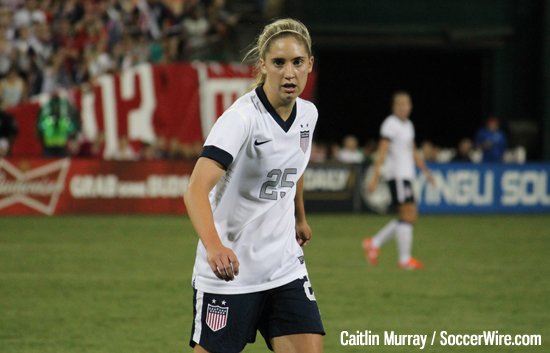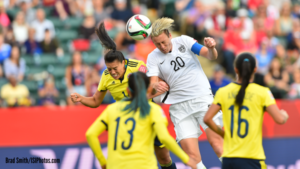Morgan Brian passed concussion tests; should she have resumed play for USWNT?

I know that this is not going to make me popular, but someone has got to say it.
Not every collision spells concussion.
The collision between U.S. Women’s National Team midfielder Morgan Brian and Germany’s Alexandra Popp in Tuesday’s Women’s World Cup semifinal has the concussion lines a-buzzin’. Taylor Twellman‘s tweeting and Briana Scurry‘s Facebooking. From my living room, it looked rough. Brian is face down in the turf, and Popp is bleeding profusely from the scalp.
Head wounds do bleed and rocking noggins does hurt. But concussion is a different matter entirely.
And this is our dilemma. Everyone watching is an amateur when it comes to medical assessment, except the professionals qualified to make that call who were attending to those players on the field. The camera shots of USWNT coach Jill Ellis watching from the sidelines showed the tense concern we all felt. Not a single person in the stadium wants to see Brian — who may be having the game of her life — come out of that game. I am certain the fans feel the same way about Popp.
Certainly not their coaches.
“I have absolute faith and trust in our medical team to do the right thing,” said Ellis afterward. “I would never question our doctors.”
Silvia Neid, Germany’s coach, said, “If the player says to our doctor she is well, and the doctor can look in her eyes and can verify that, then I don’t know why we need a neutral physician.”
Both coaches are doing what they need to do. Letting the medical personnel evaluate their players in the time now allotted by FIFA rules. These three minutes, many will say, falls well short of what’s needed to make a careful examination. To apply the balance testing and SCAT3 evaluation used by experts to assess for concussion would require at least 10 minutes in a calm, quiet space, not in the heat of battle in a deafening stadium.
+READ: Lori Chalupny U-turn raises doubts about U.S. Soccer’s concussion policies
This, of course, is impossible here. The players would need to be pulled from the game, concussion or not, just to be sure they didn’t have a concussion. This is why Scurry and Brandi Chastain, among others, are calling for a change in rules which would allow a fourth, injury-specific substitution, in addition to the current allotment of three.
My question is: when you take Brian back to the locker room, test her and she doesn’t show symptoms of concussion, what do you do? Professional rules don’t allow her to return to play, once she’s taken out. Do we need to re-assess this?
 Certainly, we don’t let the player make their own call.
Certainly, we don’t let the player make their own call.
With game adrenalin flowing and the potential for brain injury looming, we have seen this played out in alarming ways in the men’s World Cup and men’s Premier League games where players have apparently lost consciousness and/or awareness and have shaken off medical advice and been allowed to continue. A similar circumstance occurred before with Abby Wambach, when she was playing for the Western New York Flash in NWSL.
But even if we stopped the game and everyone sat silently for an extended time to allow careful evaluation, if professionals gave the go-ahead, would we be satisfied to let them play, given that we just witnessed a frightening crash? We know they sometimes result in serious, and occasionally fatal, outcomes. How can they be okay to play after that?!
Sometimes, they are. We, watching near and far, are not qualified to make the call. These coaches did what is advised: listened to the team doctors. And the players continued. Is there too much pressure on medical personnel to let the players resume? I hope, given what’s at stake for these medical professionals, that there isn’t.
+READ: Taking Action Against Concussions: Eight things you can do with your team right now
But the incident raises the issue of the confounding nature of the concussion injury. Sometimes, after collision or impact, when players are given fair and proper testing on site, by trained personnel, they don’t experience symptoms of concussion. Every collision is different. Every player is different. Every brain is different. And even given all that, concussion symptoms sometimes don’t surface until hours or even days later.
That is why I am relieved to hear that the U.S. medical staff are continuing to test and monitor Brian for symptoms of a concussion. I am sure, at the very least, she woke up on Wednesday with a doozy of a headache.
Jill Ellis says Morgan Brian has trained fully last few days & is 100% ready for the final, despite head-to-head collision in semi. #uswnt
— Jeff Carlisle (@JeffreyCarlisle) July 3, 2015
But the circumstances of this momentous and dangerous collision allow us to take an important look at the concussion issue for our youth players. We can completely subscribe to the recommendations of medical associations and youth sports organizations: “If in doubt, sit them out.” But when it’s for all the marbles, the rules change. Clearly, the World Cup is big marbles.
But let’s not pretend that our regional games, state championships, league championships, college-scouts-are-there tournament games aren’t, in their moment, for all of our marbles. They are our World Cup games. More and more, these games are attended by, and the players tended to, by well-trained athletic trainers and doctors who know concussion evaluation protocol. They, presumably, are not swayed by which team is ahead or “needs” this win. Still, in these games, if players pass the tests, they are eligible to re-enter the contest.
 This is a no-brainer for Ellis and Neid. Their stars go back in. What about us? Our kids? Do they go back in? They may be clear today but develop symptoms tomorrow. How can we know? We don’t really. But do we sit them, just to be safe?
This is a no-brainer for Ellis and Neid. Their stars go back in. What about us? Our kids? Do they go back in? They may be clear today but develop symptoms tomorrow. How can we know? We don’t really. But do we sit them, just to be safe?
Concussion is a particularly devilish injury because we can’t see its effects. In spite of science charging in with “new” evaluation tools, “more reliable” assessments, blood tests, specialty scans, impact padding, acceleration monitors and the rest, there is nothing yet, and I don’t know if we ever will have, any instant indicator that turns red for stop and yes for go on this.
But if a player passes the medical evaluation, she has been given the green light to return. If I’m the coach I don’t douse my concern, but my hands aren’t tied. I watch her play every second after she returns to the match. If I’m Jill Ellis, I have a trainer’s eyes glued to her play. The second she loses balance, is slow to respond, steps back from a challenge, she’s done.
But I have to say that on Tuesday night Morgan Brian’s play showed no signs of impairment. Other than perhaps shying away from some aerial challenges, which may show smarts rather than fear — she did graduate from UVA after all — she showed no signs of imbalance, delay, or impediment. That appeared to be confirmation of Dr. Zoric’s call.
Granted, at the moment when you, as parent or coach, make the decision to allow a player to stay in the game, you don’t have her “second-half performance” as data to evaluate. Neither did Coach Ellis.
Of course, you also don’t have a whole world of Wednesday morning quarterbacks watching and second-guessing you, either.
SOCCERWIRE MARKETPLACE
- Adidas National Cup 2026
- Adidas Showcase 2025
- Adidas Preseason Clash 2025
- Capital Fall Classic 2025 - Register by October 1st
- Applications are Now Open for the 2026 Jefferson Cup
- Start the Season Strong at Loudoun Premier Cup!
- 50th Annual Rael Vodicka Memorial Tournament
- Soccer Marketing Internships at The St. James FC
- Job Opening: The St. James FC Goalkeeper Academy Coach
- Full-Time Director of Goalkeeping for The St. James FC











